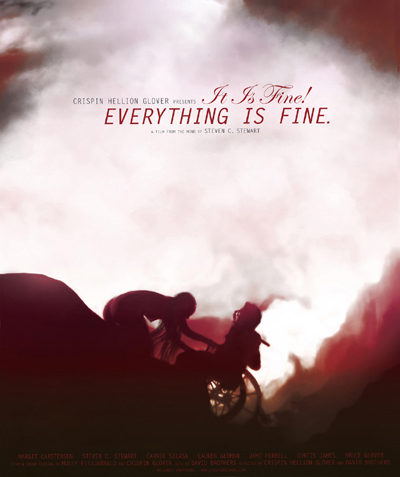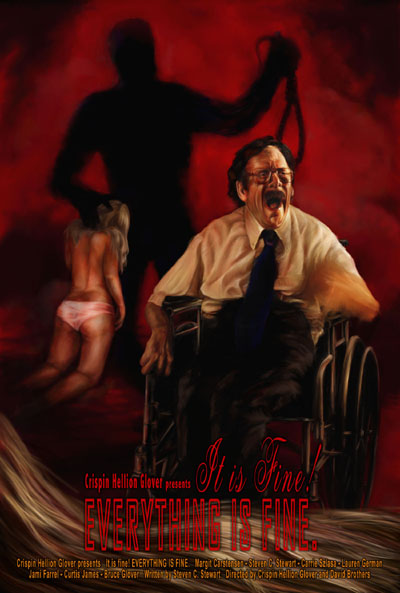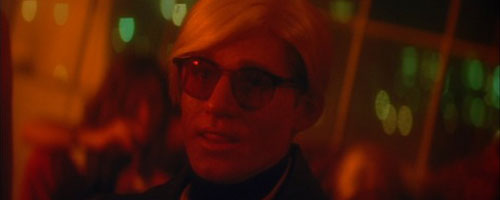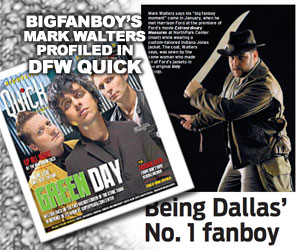I’m re-presenting an interview I did a few years ago with Crispin Glover, since he’s appearing this weekend at the historic Texas Theatre for two special presentations. This was originally posted in 2011 when Glover first appeared in Dallas. I’ve always found him to be a fascinating actor with a wide array of memorable roles. Last time he was here I sadly missed the shows, but this weekend I plan to be there no matter what. Crispin will be appearing on Saturday, February 15 at 7pm, and Sunday, February 16 at 6pm. Full info on his appearances in Dallas this weekend HERE.
In my career as a journalist, I’ve been lucky enough to talk to several interesting people both inside and outside of the entertainment world. I’m slowly but surely checking names off a list, and in the process I’ve met and/or chatted with many people I never expected to. There’s a short list of names I’ve always wanted to talk to but never had to chance. On that list was Crispin Glover. As an actor, he’s a force to be reckoned with, displaying incredible range and gravitas. As a man, I find him endlessly fascinating and creative. Our friends at the Texas Theatre are hosting a special appearance this coming weekend by Crispin, for his “Big Slide Show” presentation. I was already familiar with this because my friend Ed Dennis in D.C. saw it, met Glover, and couldn’t stop talking about how amazing the whole experience was. When I heard I could interview Crispin to help promote the event this weekend, it was a moment of genuine journalistic glee. What made the experience even better was how thorough and candid Glover ended up being with his answers. Check out what is one of my new favorite interviews below, and be sure to look for more info on the show this weekend HERE (events Saturday and Sunday night). My thanks to Crispin Glover for his time and enthusiasm… please don’t miss the show this weekend, it’s sure to be amazing. Oh, and I realize the word “Definitive” may be a little assuming, but in many ways I think we covered just about everything you’d ever want to know.
Mark: Thanks for taking time to chat, Crispin. You’ve always been on my “most-wanted” interview list. I was particularly excited to hear you were coming to the historic Texas Theatre for a presentation this coming weekend. A friend of mine up in D.C. saw you do this, and couldn’t say enough good things about the experience. You’ve always been a fan-favorite performer in films, but at what point did you first decide to bring your talents to filmmaking?
Crispin: I have written and drawn since before the age of 8. I started acting professionally at age 13 and started making super 8 films at that same time.
Mark: I don’t want to spoil the fun, but can you tell fans some of what they can expect from the “Big Slide Show” this weekend? What makes this a can’t miss event?
Crispin: I suppose there is no such thing as a can’t miss event other than one’s own entire life, but since you ask about the “Crispin Hellion Glover’s Big Slide Show” I will describe that more. The live aspect of the show is not to be underestimated. This is a large part of how I bring audiences in to the theater and a majority of how I recoup is by what is charged for the live show and what I make from selling the books after the shows.
For “Crispin Hellion Glover’s Big Slide Show” I perform a one hour dramatic narration of eight different books I have made over the years. The books are taken from old books from the 1800’s that have been changed in to different books from what they originally were. They are heavily illustrated with original drawings and reworked images and photographs.
Mark: I want to talk about your book making. When did that inspiration first kick in, and what’s the process that goes into that for those who aren’t familiar. This all feeds into your performance work that people will get to experience this weekend, so I want to give readers a look inside something that is personal to you.
I started making my books in 1983 for my own enjoyment without the concept of publishing them. I had always written and drawn and the books came as an accidental outgrowth of that. I was in an acting class in 1982 and down the block was an art gallery that had a book store upstairs. In the book store there was a book for sale that was an old binding taken from the 1800’s and someone had put their art work inside the binding. I thought this was a good idea and set out to do the same thing. I worked a lot with India ink at the time and was using the India ink on the original pages to make various art. I had always liked words in art and left some of the words on one of the pages. I did this again a few pages later and then when I turned the pages I noticed that a story started to naturally form and so I continued with this. When I was finished with the book I was pleased with the results and kept making more of them. I made most of the books in the 80’s and very early 90’s. Some of the books utilize text from the biding it was taken from and some of them are basically completely original text. Sometimes I would find images that I was inspired to create stories for or sometimes it was the binding or sometimes it was portions of the texts that were interesting. Altogether, I made about twenty of them. When I was editing my first feature film “What is it?” There was a reminiscent quality to the way I worked with the books because as I was expanding the film in to a feature from what was originally going to be a short, I was taking film material that I had shot for a different purpose originally and re-purposed it for a different idea and I was writing and shooting and ultimately editing at the same time. Somehow I was comfortable with this because of similar experiences with making my books.
When I first started publishing the books in 1988 people said I should have book readings. But the book are so heavily illustrated and they way the illustrations are used within the books they help to tell the story so the only way for the books to make sense was to have visually representations of the images. This is why I knew a slide show was necessary. It took a while but in 1992 I started performing what I used to call “Crispin Hellion Glover’s Big Side Show.” People get confused as to what that is so now I always let it be known that it is a one hour dramatic narration of eight different profusely illustrated books that I have made over the years. The illustrations from the books are projected behind me as I perform the show. There is a second slide show now that has 7 books and it performed if I have a show with Part 1 of the “IT” trilogy and then on the subsequent night I will perform the second slide show and Part 2 of the “IT” trilogy.
The fact that I tour with the film helps the distribution element. I consider what I am doing to be following in the steps of vaudeville performers. Vaudeville was the main form of entertainment for most of the history of the US. It has only relatively recently stopped being the main source of entertainment, but that does not mean this live element mixed with other media is no longer viable. In fact it is apparent that it is sorely missed.
I definitely have been aware of the element of utilizing the fact that I am known from work in the corporate media I have done in the last 25 years or so. This is something I rely on for when I go on tour with my films. It lets me go to various places and have the local media cover the fact that I will be performing a one hour live dramatic narration of eight different books which are profusely illustrated and projected as I go through them, then show the film either What is it? Being 72 minutes or It is fine! EVERYTHING IS FINE being 74 minutes. Then having a Q and A and then a book signing. As I funded the films I knew that this is how I would recoup my investment even if it a slow process.
Volcanic Eruptions was a business I started in Los Angeles in 1988 as Crispin Hellion Glover doing business as Volcanic Eruptions. It was a name to use for my book publishing company. About a year later I had a record/CD come out with a corporation called Restless Records. About when I had sold the same amount of books as CD/records had sold it was very clear to me that because I had published my own books that I had a far greater profit margin. It made me very suspicious of working with corporations as a business model. Financing/Producing my own films is based on the basic business model of my own publishing company. There are benefits and drawbacks about self distributing my own films. In this economy it seems like a touring with the live show and showing the films with a book signing is a very good basic safety net for recouping the monies I have invested in the films.
There are other beneficial aspects of touring with the shows other than monetary elements. There are benefits that I am in control of the distribution and personally supervise the monetary intake of the films that I am touring with. I also control piracy in this way because digital copy of this film is stolen material and highly prosecutable. It is enjoyable to travel and visit places, meet people, perform the shows and have interaction with the audiences and discussions about the films afterwards. The forum after the show is also not to under estimated as a very important part of the show for for the audience. This also makes me much more personally grateful to the individuals who come to my shows as there is no corporate intermediary. The drawbacks are that a significant amount of time and energy to promote and travel and perform the shows. Also the amount of people seeing the films is much smaller than if I were to distribute the films in a more traditional sense.
The way I distribute my films is certainly not traditional in the contemporary sense of film distribution but perhaps is very traditional when looking further back at vaudeville era film distribution. If there are any filmmakers that are able to utilize aspects of what I am doing then that is good. It has taken many years to organically develop what I am doing now as far as my distribution goes.
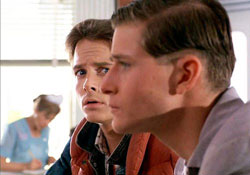 Mark: You’ve had an amazing body of work through the years, but I imagine a majority of fans like to bring up George McFly, which of course has become one of those indelible film characters through the years that everyone adores. There’s been a lot of interviews with others in the “Back to the Future” cast, but I’m curious what your experience was like working on that film. Can you talk a little about getting cast as George, working with Robert Zemeckis, and the somewhat surprising explosion of fandom that came out of all that?
Mark: You’ve had an amazing body of work through the years, but I imagine a majority of fans like to bring up George McFly, which of course has become one of those indelible film characters through the years that everyone adores. There’s been a lot of interviews with others in the “Back to the Future” cast, but I’m curious what your experience was like working on that film. Can you talk a little about getting cast as George, working with Robert Zemeckis, and the somewhat surprising explosion of fandom that came out of all that?
Crispin: I am glad that I was in the original film. It is funny that I have been asked far less about my experiences of having worked on this film than I have on a lot of other things to the point that really not a lot has been said. There is certainly a lot to say about my experience working on the film and I will have to write it down at some point.
Mark: I’m not in any way trying to bring up a sore point, but I know you’ve mentioned in other interviews that Bob Gale had made some negative comments about your exiting of the franchise, and you pointed out how your situation with those films actually brought about new SAG regulations. Is it the kind of thing that leaves a bad taste in your mouth over the experience, or were the pleasurable experiences of working on the first film something that outweighed any negative aspects that came afterward?
Crispin: I am glad I am in the original film. When I was in the original film it was not a franchise so I did not exit a franchise. What happened was no financial agreement was made for me to appear in the sequels. Bob Gale was a co writer and co producer of the films. He was the person that my agent spoke with last when the negotiations were happening. The trouble with the negotiations is that there really wasn’t a negotiation. They offered me less than half of what Tom Wilson and Lea Thomson were getting and never moved upward. In fact when the one long screenplay that was what became BTTF2 and BTTF3 was expanded in to two films they actually lowered the dollar amount they offered me for each film.
 It was exceedingly clear to my agents and myself that I was not wanted by the producers to appear the films. There are complexities to why I think this happened, but for brevity sake suffice it to say that after “Back to the Future” came out the highest profile media I had done was the film River’s Edge and some publicity for that film which included appearances on Late Night Talk Shows. It seemed that Bob Gale was not impressed with either my work or appearances on the Late Night Talk Shows and Bob Gale and the producers felt that that I did not deserve to be making the same amount that Lea Thompson or Tom Wilson were making to appear in the sequels. I was actually offered a better deal for another film so I acted in the other film while they shot BTTF 2. The final offer for me to appear in BTTF 2 was $125,000. This was an unacceptable dollar amount to myself and my agents and I was fine with the idea that another actor would play the role. Instead of another actor being cast to play the role, the producers used casts of my face from the original film to make prosthetics to put on another actor to make that actor look like me. They then inter-spliced a very small amount of footage of me from the original film in order to fool audiences in to believing that I had appeared in the film.
It was exceedingly clear to my agents and myself that I was not wanted by the producers to appear the films. There are complexities to why I think this happened, but for brevity sake suffice it to say that after “Back to the Future” came out the highest profile media I had done was the film River’s Edge and some publicity for that film which included appearances on Late Night Talk Shows. It seemed that Bob Gale was not impressed with either my work or appearances on the Late Night Talk Shows and Bob Gale and the producers felt that that I did not deserve to be making the same amount that Lea Thompson or Tom Wilson were making to appear in the sequels. I was actually offered a better deal for another film so I acted in the other film while they shot BTTF 2. The final offer for me to appear in BTTF 2 was $125,000. This was an unacceptable dollar amount to myself and my agents and I was fine with the idea that another actor would play the role. Instead of another actor being cast to play the role, the producers used casts of my face from the original film to make prosthetics to put on another actor to make that actor look like me. They then inter-spliced a very small amount of footage of me from the original film in order to fool audiences in to believing that I had appeared in the film.
The producers did not own me. They did not agree for a fee for me to appear in their film. The producers decided it was better to steal my image instead and fool audiences instead. Because of my lawsuit there are now rules in the Screen Actors Guild so that producers and actors can never do something like that again. When Bob Gale addresses the questions about being the main architect of what led to illegal activity rather than be honest and apologize for the criminal activity, Bob Gale has chosen the path of lack of character and now lies about the situation and falsely states that I asked for the same amount of money as Michael J. Fox. Bob Gale has made this up to obfuscate what he did that led to illegal activity.
Even though it is true that Steven Spielberg was part of the lawsuit it should be made clear that creative impetus for utilizing another actor in prosthetics to make him look like me and inter-splicing small portions of my performance from the original film in order to fool audiences in to believing I was in the sequel came more from the mind of Bob Gale. It should be noted that Bob Gale has not worked in the film industry since 2004 and as of 2008 became a regular writer for Spider-Man. Steven Spielberg purchased many of Bob Gale’s screenplays and never produced them. This may have contributed to rendering Bob Gale out of work in the film industry. It is possible this was a retaliatory gesture by Steven Spielberg for involving him in a lawsuit that ended up causing changes in SAG rules so producers and actors can never do something like that again. All specific details about me asking for the same amount as Michael J. Fox are by Bob Gale. I believe Bob Gale is bitter about the fact that what he did led to illegal activity. Perhaps Bob Gale’s stoppage of work in the film industry it is all coincidence. In any case I am proud of standing up for myself and other actor’s legal rights.
.
Mark: I want to bring up “River’s Edge”, which I think is a fascinating performance, and a very interesting film. I saw someone make a comment that it was the best David Lynch film that David Lynch didn’t direct. Can you talk a bit about your experience on that project, and the inspirations behind your character? It’s a movie I’m not sure a lot of people fully appreciate.
Crispin: I had a great time working on that film. The way the dialogue was written had a familiar sound to how I had heard people speaking so I utilized a particular speaking pattern I was familiar with. The screenplay was based on real events, but the characters were fictionalized. I was sent the screenplay through my agents. It was an excellent screenplay and I responded to the role. I auditioned for it and I got the role and had an excellent time working making that film and am proud of it.
Mark: That also leads me into you working with David Lynch on “Wild At Heart”, which in its own right is an unusually compelling work. I’m curious about any memories you may have from those days, and perhaps any lasting impressions Lynch may have had on you from a creative aspect.
Crispin: David Lynch was great to work with as a director. I had been very influenced when I was 16 years old and went to see “Eraserhead” projected at the Nuart Theater in Los Angeles many times. It was fascinating working with him when I played Cousin Dell in “Wild at Heart.” That performance is probably the most specifically directed performance by a director I have performed, and because it was directed by such an excellent director it is one of my favorite performances of myself and I get a lot of compliments on it.
David Lynch had influence on “What is it?” in one way that was very business oriented: I had co-written a screenplay in which I put the concept of the majority of the characters to be played by actors with Down’s Syndrome. This screenplay is called “IT IS MINE.” David Lynch had agreed o executive produce this film for me to direct which was very helpful. I went to one of the major film funding corporation in Los Angeles that was interested in funding the film. After a number of meetings and conversations they let me know that they were concerned about funding a film wherein most of the characters were to be played by actors with Down’s Syndrome. So it was decided that I should write a screenplay to make what was originally going to be a short film to promote that it was a viable idea to have most of the characters in a film be played by actors with Down’s Syndrome. This screenplay was “What is it?” And it is what has eventually become the feature “What is it?”
Mark: You followed that film with “The Doors” working with Oliver Stone, and might I say I doubt there will ever be a better interpretation of Andy Warhol on the big screen. Was it fun getting to sink your teeth into playing such an iconic personality like that, and how artistically collaborative was Oliver on that film?
Crispin: I met and spoke with Andy Warhol at Madonna and Sean Penn’s wedding. It was right after “Back to the Future” had come out which he had apparently seen. I did not speak with him for so long but definitely enough to get an idea about him. He was quite nice to me. I stood back and looked watched how he held himself and thought he would be an interesting person to play. I’d had a good meeting with Oliver Stone for “Platoon” and I pursued the role when I heard there was an Andy Warhol role in “The Doors” movie. I auditioned and I got the role. I asked for some of the lines to be removed and Oliver Stone obliged. He was excellent to work with. Oliver Stone also produced Milos Foreman’s “The People VS. Larry Flynt” which I had a great time working on.
 Mark: Moving ahead a bit, when you played Thin Man in the “Charlie’s Angels” movies, I think that was an interesting turning point for a lot of people, as we got to see a really dark and fairly sadistic side of you. I imagine there’s a good portion of fans who weren’t aware you had that sort of physical prowess, and I’m also betting as fun as the movie was to watch, it was probably a lot of hard work in the making. What recollections do you have on those experiences?
Mark: Moving ahead a bit, when you played Thin Man in the “Charlie’s Angels” movies, I think that was an interesting turning point for a lot of people, as we got to see a really dark and fairly sadistic side of you. I imagine there’s a good portion of fans who weren’t aware you had that sort of physical prowess, and I’m also betting as fun as the movie was to watch, it was probably a lot of hard work in the making. What recollections do you have on those experiences?
Crispin: I had an excellent time working on the “Charlie’s Angels” films. I was able to fund shooting “It is fine. EVERYTHING IS FINE.” with the money I made from the first Charlie’s Angels film. I should talk about the films I will be showing here and there go in to some detail about the “Charlie’s Angels” films as well.
I am very careful to make it quite clear that What is it? is not a film about Down’s Syndrome but my psychological reaction to the corporate restraints that have happened in the last 20 to 30 years in film making. Specifically anything that can possibly make an audience uncomfortable is necessarily excised or the film will not be corporately funded or distributed. This is damaging to the culture because it is the very moment when an audience member sits back in their chair looks up at the screen and thinks to their self “Is this right what I am watching? Is this wrong what I am watching? Should I be here? Should the filmmaker have made this? What is it?” -and that is the title of the film. What is it that is taboo in the culture? What does it mean that taboo has been ubiquitously excised in this culture’s media? What does it mean to the culture when it does not properly process taboo in it’s media? It is a bad thing because when questions are not being asked because these kinds of questions are when people are having a truly educational experience. For the culture to not be able to ask questions leads towards a non educational experience and that is what is happening in this culture. This stupefies this culture and that is of course a bad thing. So What is it? Is a direct reaction to the contents this culture’s media. I would like people to think for themselves.
Steven C. Stewart wrote and is the main actor in part two of the trilogy titled It is fine! EVERYTHING IS FINE. I put Steve in to the cast of What is it? because he had written this screenplay which I read in 1987. When I turned What is it? from a short film in to a feature I realized there were certain thematic elements in the film that related to what Steven C. Stewart’s screenplay dealt with. Steve had been locked in a nursing home for about ten years when his mother died. He had been born with a severe case of cerebral palsy and he was very difficult to understand. People that were caring for him in the nursing home would derisively call him an “M.R.” short for “Mental Retard”. This is not a nice thing to say to anyone, but Steve was of normal intelligence. When he did get out he wrote his screenplay. Although it is written in the genre of a murder detective thriller truths of his own existence come through much more clearly than if he had written it as a standard autobiography. As I have stated, I put Steven C. Stewart in to What is it? When I turned What is it? in to a feature film. Originally What is it? Was going to be a short film to promote the concept to corporate film funding entities that working with a cast wherein most characters are played by actors with Down’s Syndrome. Steve had written his screenplay in in the late 1970’s. I read it in 1987 and as soon as I had read it I knew I had to produce the film. Steven C. Stewart died within a month after we finished shooting the film. Cerebral palsy is not generative but Steve was 62 when we shot the film. One of Steve’s lungs had collapsed because he had started choking on his own saliva and he got pneumonia. I specifically started funding my own films with the money I make from the films I act in when Steven C. Stewart’s lung collapsed in the year 2000 this was around the same time that the first “Charlie’s Angels” film was coming to me. I realized with the money I made from that film I could put straight in to the Steven C. Stewart film. That is exactly what happened. I finished acting in “Charlie’s Angels” and then went to Salt Lake City where Steven C. Stewart lived. I met with Steve and David Brothers with whom I co-directed the film. I went back to LA and acted in an lower budget film for about five weeks and David Brothers started building the sets. Then I went straight back to Salt Lake and we completed shooting the film within about six months in three separate smaller productions. Then Steve died within a month after we finished shooting. I am relieved to have gotten this film finally completed because ever since I read the screenplay in 1987 I knew I had to produce the film and also produce it correctly. I would not have felt right about myself if I had not gotten Steve’s film made, I would have felt that I had done something wrong and that I had actually done a bad thing if I had not gotten it made. So I am greatly relieved to have completed it especially since I am very pleased with how well the film has turned out. We shot It is fine! EVERYTHING IS FINE. while I was still completing What it? And this is partly why What is it? took a long time to complete. I am very proud of the film as I am of What is it? I feel It is fine! EVERYTHING IS FINE. will probably be the best film I will have anything to do with in my entire career. People who are interested in when I will be back should join up on the e mail list at CrispinGlover.com as they will be emailed with information as to where I will be where with whatever film I tour with. It is by far the best way to know how to see the films. After “Charlie’s Angels” came out it did very well financially and was good for my acting career. I started getting better roles that also paid better and I could continue using that money to finance my films that I am so truly passionate about. I have been able to divorce myself from the content of the films that I act in and look at acting as a craft that I am helping other filmmakers to accomplish what it is that they want to do. Usually filmmakers have hired me because there is something they have felt would be interesting to accomplish with using me in their film and usually I can try to do something interesting as an actor. If for some reason the director is not truly interested in doing something that I personally find interesting with the character then I can console myself that with the money I am making to be in their production I can help to fund my own films that I am so truly passionate about. Usually though I feel as though I am able to get something across as an actor that I feel good about. It has worked out well!
 Mark: And then we get “Willard”, which was one of those moments I remember – when I heard you were the lead in the update – I got very excited. Seems like a great project to be involved in. Was it daunting at all trying to modernize a classic film like that?
Mark: And then we get “Willard”, which was one of those moments I remember – when I heard you were the lead in the update – I got very excited. Seems like a great project to be involved in. Was it daunting at all trying to modernize a classic film like that?
Crispin: I did not see the original film till after my deal had been reached for me to appear in the version that I did. I wanted to see of there was anything I could glean from Bruce Davison’s performance. When I viewed the 1971 “Willard” I liked it and thought Bruce Davison’s performance was excellent, but there screenplay I had read was a substantially different character from what the character was in the 1971 film so I had to go in to the screenplay for figuring out the character. I had worked hard on the emotional aspects of that character and had an excellent time working on that film.
Mark: Okay, last movie question, I promise. You worked with Tim Burton in “Alice in Wonderland”, which was a huge film, and a artistic wonder to behold. Again, I remember thinking “Crispin Glover working with Tim Burton… that’s perfect.” I know you did voice work on 9 the year prior, but how exactly did your Wonderland role fall into place, and I have to know what shooting a movie like that was like. Oh, and I have to ask if Tim was good-natured about your “Charlie and the Chocolate Factory” parody in “Epic Movie.”
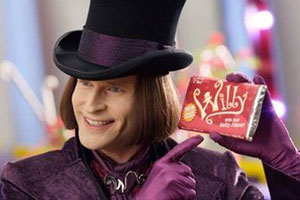 Crispin: I was touring in Australia with my shows and films when I got word from my agents that there was interest in me for the film. I was supposed to continue on from Australia in to Europe, but I had to postpone those shows till later as working with Tim Burton on “Alice in Wonderland.”
Crispin: I was touring in Australia with my shows and films when I got word from my agents that there was interest in me for the film. I was supposed to continue on from Australia in to Europe, but I had to postpone those shows till later as working with Tim Burton on “Alice in Wonderland.”
“Epic Movie” has never come up in discussion between Tim Burton and I. Working with Tim Burton was a great experience!
Mark: I’ve always found you to be a fascinating and extremely talented individual, and it’s a rare treat for me to be able to conduct this interview. Would you like to leave us with any news on upcoming projects, or perhaps a final thought or two?
Crispin: Please let people know to sign up for my newsletter on CrispinGlover.com or the Official Crispin Hellion Glover Facebook page or CrispinGlover on Twitter to get information on my shows.



